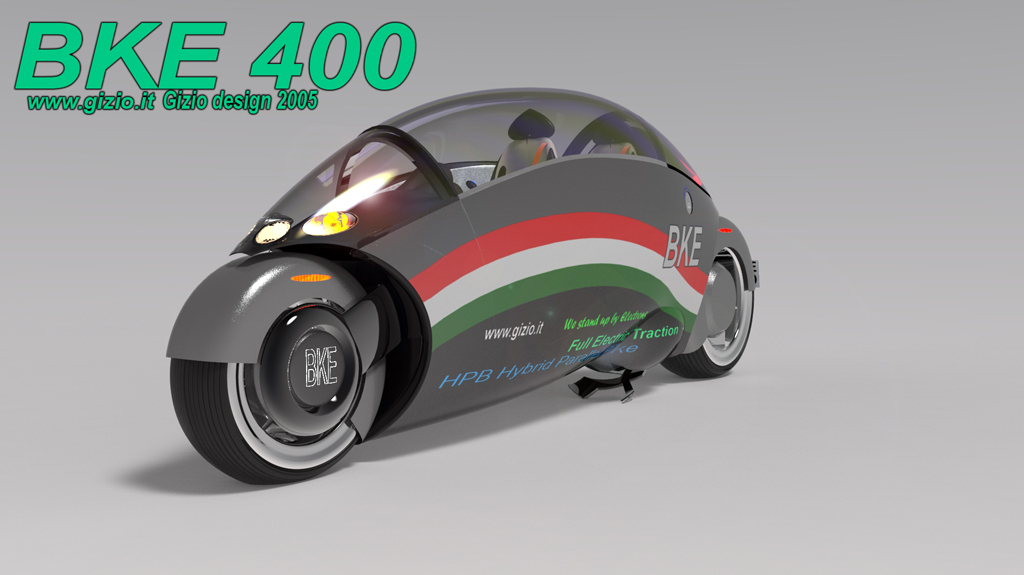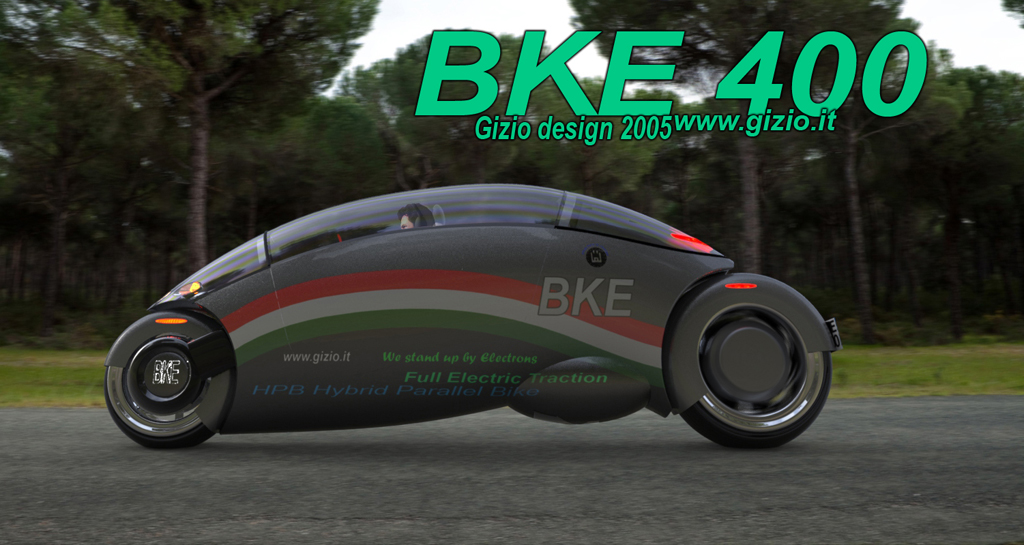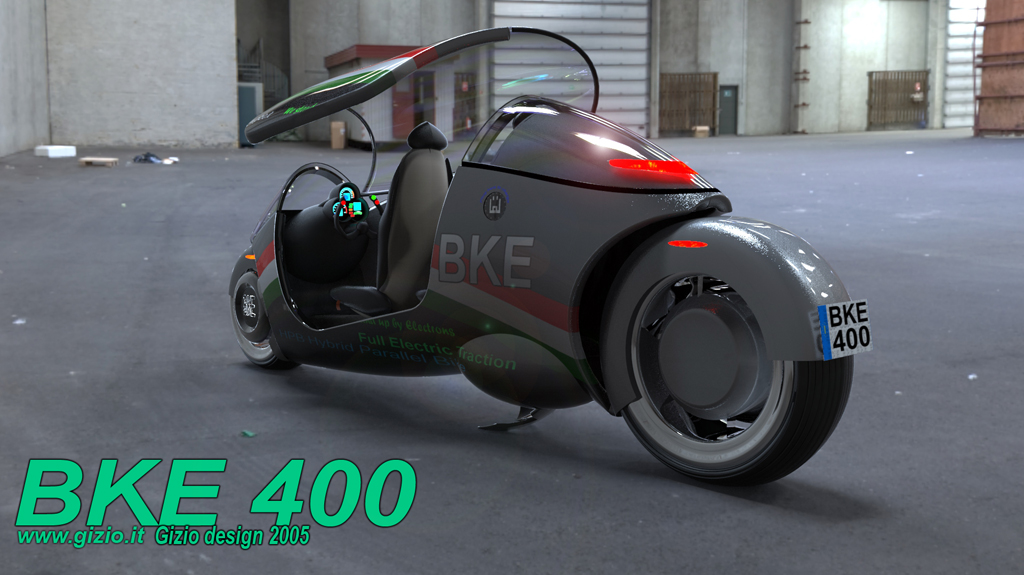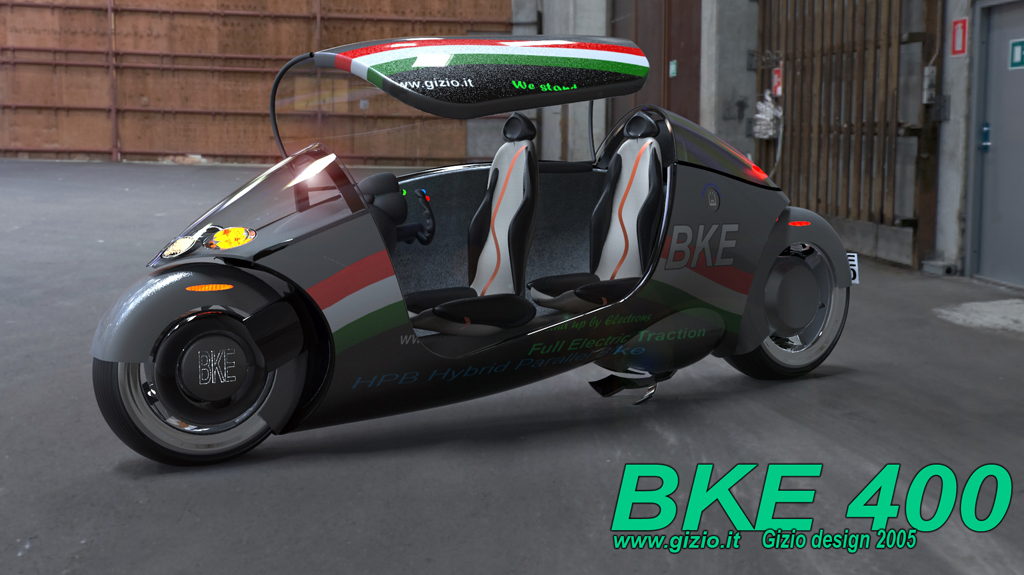It is simple an electric two-wheeled vehicle, powered through an hybrid parallel system, there isn’t any mechanical part, transmission, gears or whatever, it is just equipped with an engine-generator and a battery pack, either feed alternately the two electric motors positioned one in the front wheel and in the other in the rear one ensuring the full traction of the vehicle on both wheels.
POWER SYSTEM: A PARALLEL HYBRID TYPEThe charging of the batteries can take place both while the vehicle is running, through the motor generator, when batteries have exhausted the available energy, or normally through a home connector allowing the vehicle to have an extended autonomy beyond the battery-pack endurance.
The
motor-generator 400 cc turbo-powered by alcohol or bio-fuel
will start automatically once the batteries are exhausted providing the
electric power for both, traction as well charging the battery-pack. This
allows an optimal use of the energy produced by the engine which has a
reduced displacement since normally a conventional mechanical transmission
absorb about 30 percent of the energy produced by the motor. Parallel
hybrid instead are transmission-less, and both the weight and also the
space of this useless organ is here to the advantage of the battery-pack,
making the vehicle less complex and pretty much convenient in term of
efficiency.
Thermal energy produced by the motor-generator can be transformed in electric
power simultaneously to recharge the batteries of the car, allowing considerable
energy recovery properly stored in the battery-pack as well allowing pilot
to extend its range of action without endurance limits.

| Driving/Vehicle's
Attitude It
'easy to drive! Its architecture remind of a two-seat military aircraft,
since both the aerodynamic shape as well its behavior on the road
are very close to that of a stunt plane. That's why I preferred
to use an aircraft driving-wheel type that reminds one of those
aboard an aircraft, circular instrumentation rather than a classic
rectangular display give the whole machine a vintage-like
style. |

The
idea of style that accompanies this vehicle meets two planets very distant
from each other, something that oscillates constantly between the classical
and the modern way a bike should be.
The great-fifties exploded with beautiful bikes like the Indian, the Harley
etc, that inspired my imagination combined with the beautiful exiting
aerodynamics shape of a military plane; all that mixed in a single design
concept
The whole project was basically looking at the future and thus the shape
of the 'fuselage' is extremely wind-stream, but as well match with the
line of the wheel guards, which wrap the tire recalling precisely those
of an Indian or a Harley. A unique door allows access to the passenger
vane, the environment is comfortable and is provided of two pneumatic
seats making then lighten than conventional ones.
The machine is built on a frame that supports the engine-generator; the
battery-pack and a lightweight plastic body that is directly bolted to
the main frame, therefore the Bike-car is quite light and easy even for
a complex maintenance, finally the control systems and actuators
are both servo-electric.

| CONCLUSIONS
The
hybrid-serial formula is the temporary solution to which I’m
working to, for years through many projects even more important
mainly dedicated to aircraft, however a considerable number of my
design production having this style have been also conceived in
the past years also for cars and two wheels vehicle as this case
for the
BKE 400. Future is already around the corner but for some unreasonable “reasons” is somewhere restricted by both commercial as well internationsl oil markets interests. I believe that the jumping piston engine is quite long obsolete and outdated, after all is like to drive a car having a steam engine in the cowling. |

The
electric motor is the best way to move, it’s clean and quiet,
simple in its architecture and has a very high efficiency. However
accumulators and batteries available at the moment are not yet capable
to ensure a very extended autonomy comparable to that of traditional
combustion systems. So until the final changeover to full-electric
traction the best way to go through it, should be at moment addressing
my attention also to a sort of technological compromise, that keeps
together the two formulas in the best possible way. The parallel hybrid system allows this opportunity, because the electric traction is the main drive of the machine, while the combustion engine acts as a generator for to power the electric motors as well to recharge the batteries on board. Such a machine does not require a transmission or any addictional mechanical parts, all that is replaced by electric wires and digital control systems, rather that gear boxes, shafts and levers, which makes the combination much more efficient and affordable, whatever it is a Car or an Aircraft, opening both technological and economic interesting perspectives, electric propulsion will be the main force of future trasportation system. |